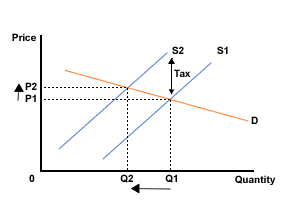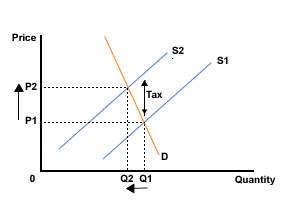PED and taxation
The imposition of a tax will mean that the price goes up (as supply shifts to the left). However, the amount of the price increase will depend on the elasticity of demand. Compare Figures 1 and 2 to see the difference.

Figure 1 Tax imposed on a good with elastic demand

Figure 2 Tax imposed on a good with inelastic demand

1 |
Tax revenueIf you aimed as a government solely to reduce the consumption of the good, which type of good would you be taxing? |
2 |
Tax revenue (2)If you aimed as a government to tax goods simply to raise tax revenue, which type of good would you tax? |
So, for a government wishing to raise revenue from indirect taxation, they will always tend to impose the taxes on goods with relatively inelastic demand. The more inelastic the demand, the more the price will rise and therefore the more of the tax will be passed on to the consumer.
